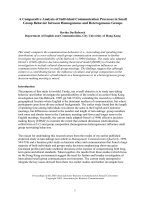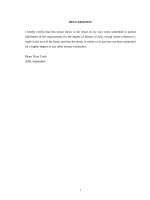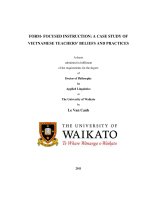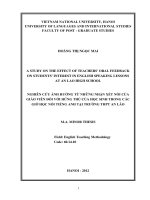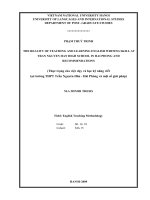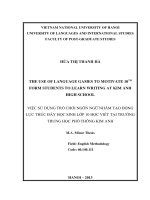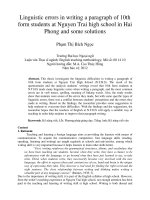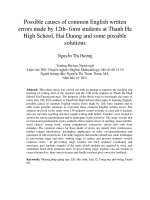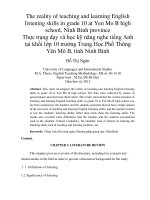Teachers beliefs and practices of intercultural communication competence in teaching and learning english a survey at a local high school in phu tho province
Bạn đang xem bản rút gọn của tài liệu. Xem và tải ngay bản đầy đủ của tài liệu tại đây (1.24 MB, 76 trang )
VIETNAM NATIONAL UNIVERSITY, HANOI
UNIVERSITY OF LANGUAGES AND INTERNATIONAL STUDIES
FACULTY OF POST-GRADUATE STUDIES
----------
HOÀNG THỊ HIỀN
TEACHERS’ BELIEFS AND PRACTICES
OF INTERCULTURAL COMMUNICATION COMPETENCE
IN TEACHING AND LEARNING ENGLISH:
A SURVEY AT A LOCAL HIGH SCHOOL IN PHU THO PROVINCE
(Hiểu biết của giáo viên đối với năng lực giao tiếp liên văn hóa
trong dạy và học tiếng Anh: Một nghiên cứu khảo sát
ở một trường THPT ở tỉnh Phú Thọ)
M.A. MINOR THESIS
Field: English Teaching Methodology
Code: 8140231.01
HA NOI - 2019
VIETNAM NATIONAL UNIVERSITY, HANOI
UNIVERSITY OF LANGUAGES AND INTERNATIONAL STUDIES
FACULTY OF POST-GRADUATE STUDIES
HOÀNG THỊ HIỀN
TEACHERS’ BELIEFS AND PRACTICES
OF INTERCULTURAL COMMUNICATION COMPETENCE
IN TEACHING AND LEARNING ENGLISH:
A SURVEY AT A LOCAL HIGH SCHOOL IN PHU THO PROVINCE
(Hiểu biết của giáo viên đối với năng lực giao tiếp liên văn hóa
trong dạy và học tiếng Anh: Một nghiên cứu khảo sát
ở một trường THPT ở tỉnh Phú Thọ)
M.A. MINOR THESIS
Field: English Teaching Methodology
Code: 8140231.01
Supervisor: Assoc. Prof. Dr. Lê Văn Canh
HÀ NỘI - 2019
DECLARATION OF AUTHORSHIP
I, Hoang Thi Hien, declare that this thesis and the work presented in it are my
own and has been generated by me as the result of my own original research.
I confirm that:
This work has done wholly or mainly while in candidature for a research
degree at this university.
Where any part of this thesis has previously been submitted for a degree or
any other qualification at this university or any other institution, this has been
clearly stated.
Where I have consulted the published work of others, this is always clearly
attributed.
Where I have quoted from the work of others, the source is always given.
With the exception of such quotations, this thesis is entirely my own work.
I have acknowledged all main sources of help.
Where the thesis is based on work done by myself jointly with others, I have
made clear exactly what was done by others and what I have contributed
myself.
Signed: ……………………………
Date: ………………………………
i
ACKNOWLEDGEMENTS
First of all, I would like to express my heartfelt gratitude to my supervisor,
Assoc. Prof. Le Van Canh, for his valuable guidance, constructive comments,
patient support and encouragement in the completion of this M.A. thesis. He
consistently allowed this paper to be my own work, but steered me in the right
direction whenever he thought I needed it.
I would like to send my sincere thanks to my informants in this study, who I
selected as the target subjects of this research. Without their enthusiastic
contribution and cooperation, this research would certainly not have been
successfully conducted.
My thanks also go to all my teachers for their great help in providing me with
useful advice and constructive comments.
In the thesis, it is inevitable that the ideas of many other writers in this field
are reflected and developed. Their ideas have stimulated my thinking on
doing this paper. My debt to the authors listed in the references is equally
great. To all these scholars, I offer my sincere thanks.
Finally, I must express my very profound gratitude to my family, colleagues
and friends for providing me with unfailing support and continuous
encouragement throughout my years of study and through the process of
researching and writing this thesis. This accomplishment would not have been
possible without them. My special thanks go to my parents who have always
supported me and told me that I could achieve whatever I wanted. I hope that
they would be proud of me today.
ii
It goes without saying that I am fully responsible for all shortcomings
remaining in this study.
Author
iii
ABSTRACT
This study was done aiming at finding out how teachers perceive Intercultural
Communication Competence (ICC) in teaching and learning English.
Moreover, how their beliefs are integrated in their teaching practices were
also the subjects to point out. To fulfill the abovementioned objectives, the
qualitative methodology was utilized, and the data mostly based on semistructured interviews with six teachers of English at a local high school in a
mountainous province were synthesized and analyzed. The results of the
study, in summary, showed that most of the teachers surveyed have poor
understanding of ICC, which results in their confusion about ways to improve
students’ ICC. Those beliefs and practices may be influenced by some
different factors such as teachers’ lack of experience, materials,... As a result,
suggestions and recommendations were investigated so as to deal with the
problems. Though the limitations were unavoidable, the study was expected
to be beneficial to teachers, students, and researchers of the related subjects.
iv
LIST OF ABBREVIATIONS
EFL
English as a Foreign Language
EIL
English as an International Language
ELF
English as a lingua franca
ELT
English Language Teaching
ESL
English as a Second Language
I
Interviewer
IC
Intercultural Communication
ICC
Intercultural Communication Competence
p
page
T
Teacher
U.K.
United Kingdom
U.S.
United States
v
LIST OF TABLES AND FIGURES
Figure 1: Fantini’s IC Model (2000) (1.3)
Table 1:
Teachers’ perception of culture and its importance in
p. 15
p. 34
language teaching (3.1.1)
Table 2:
Objectives of ELT in the context of globalization in
p. 36
comparison with those of traditional ELT (3.1.2)
Table 3:
Teachers’ perception of the components of ICC (3.1.3)
vi
p. 38
TABLE OF CONTENTS
DECLARATION OF AUTHORSHIP .................................................................... i
ACKNOWLEDGEMENTS ..................................................................................... ii
ABSTRACT ............................................................................................................. iv
LIST OF ABBREVIATIONS.................................................................................. v
LIST OF TABLES AND FIGURES ...................................................................... vi
TABLE OF CONTENTS ....................................................................................... vii
PART ONE: INTRODUCTION ............................................................................. 1
1. Rationale of the research problems ................................................................ 1
2. Aims of the study ........................................................................................... 2
3. Research questions ......................................................................................... 3
4. Scope of the research ..................................................................................... 3
5. Method of the study ....................................................................................... 3
6. Significance of the study ................................................................................ 4
7. Structure of the thesis ..................................................................................... 4
PART TWO: DEVELOPMENT ............................................................................ 6
CHAPTER I: LITERATURE REVIEW ........................................................... 6
1.1. The relationship between Language and Culture ........................................ 6
1.2. Cross-cultural Communication vs. Intercultural Communication ............ 10
1.3. Intercultural Communication Competence (ICC) ..................................... 13
1.4. Teaching English as a lingua franca (ELF) and Intercultural
Communication Competence (ICC) ................................................................. 16
1.5. The current pedagogy to teach ICC .......................................................... 19
1.6. The role of teachers’ beliefs and practices ................................................ 21
1.7. Previous studies on teachers’ beliefs and practices of ICC in teaching and
learning English ............................................................................................... 22
vii
Summary .......................................................................................................... 25
CHAPTER II: METHODOLOGY ................................................................... 26
2.1. The setting and participants of the study .................................................. 26
2.2. Data collection instruments ....................................................................... 28
2.3. Data collection procedure ......................................................................... 29
2.4. Data analysis ............................................................................................. 30
Summary .......................................................................................................... 32
CHAPTER III: FINDINGS AND DISCUSSION ........................................... 33
3.1. Teachers’ beliefs of ICC in teaching and learning English ...................... 33
3.2. How teachers integrate their understanding of ICC into their classroom
teaching ............................................................................................................ 40
3.3. Teachers’ ideas about effective ways of teaching ICC ............................. 44
Summary .......................................................................................................... 45
PART THREE: CONCLUSION .......................................................................... 46
1. Summaries of the major findings ................................................................. 46
2. Pedagogical recommendations to improve students’ ICC ......................... 46
3. Limitations of the study ................................................................................. 48
4. Recommendations for further related studies ............................................. 49
REFERENCES ....................................................................................................... 51
APPENDICES ........................................................................................................... I
APPENDIX A: INTERVIEW GUIDELINES .................................................... I
APPENDIX B: INTERVIEW SAMPLE.......................................................... VI
viii
PART ONE: INTRODUCTION
1. Rationale of the research problems
The rationale of this study emerged from my own experience as a graduate
student and teacher. Having been a teacher of English for more than ten years
at a high school in Vietnam, my perceptions of English teaching is affected a
lot by the way I was taught when I was a student. Like many other teachers, I
paid much attention to grammatical structures and vocabulary. Since the 7year textbook set was implemented in my school, I have always tried to apply
CLT into my teaching practices. With a view to helping students develop the
four communicative skills, I paid much attention to teach my students to
pronounce the words correctly with American or British standards. Not until I
attended the workshop “Intercultural Communicative Competence and
Education For Global Citizenship” by Prof. Nguyen Quang did I realize that I
had much to do to become a better teacher. I started to know that the ultimate
goal of teaching English is not just to help students develop the four
communicative skills, but teaching English is for global communication, for
social responsibility and for intercultural citizenship. Therefore, I was
motivated to do research on ICC to understand more about it and wish to help
my colleagues clearer about this issue.
In today’s globalized world, beside acquiring the four skills, English learners
need to develop Intercultural Communication Competence (ICC). It is
claimed to be a very important factor affecting the development of the ability
to use a foreign language, the ability to communicate and adjust attitudes of
learners in multicultural contexts. When students are equipped with the
knowledge of other cultures, they have less difficulty in communicating with
1
people coming from different backgrounds. Hence, teaching ICC along with
the English language is considered to be extremely important in order to
enable them to communicate inter-culturally, not just imitate the British or
American people. The development of ICC has become one of the ultimate
goals of English language teaching in the context of globalization; however,
the integration of intercultural content into English language education in
Vietnam has not been paid enough attention.
Although much research has been done on ICC in teaching English as a
lingua franca in a variety of different contexts, not many studies on the topic
have been conducted in the context of Vietnamese high schools. Besides, the
concept ICC is still alien to many Vietnamese EFL teachers working in the
high school. In addition, most teachers still have limited knowledge about
ICC.
For all of the abovementioned, I would like to carry out a small-scaled study
on “teachers’ beliefs and practices of ICC in teaching and learning English at
a local school in Phu Tho province” so as to help solve out the problems.
2. Aims of the study
The research has two major aims:
-
To explore high school teachers’ view about ICC in language teaching.
-
To find out how teachers integrate their understanding of ICC into their
classroom teaching.
2
3. Research questions
This study is conducted to address the two following research
questions:
1. What are high school teachers’ understandings of ICC and its importance
in teaching and learning English?
2. How is their understanding translated into classroom teaching?
4. Scope of the research
The research explores the notion of ICC in English language teaching and
learning from the perspectives of six teachers of English at a local high school
in Phu Tho. Regarding its scope, the research was only aimed at exploring
teachers’ understanding of ICC and how it is translated into their teaching.
5. Method of the study
The method used in this study is survey research, with the use of one main
instrument which is interview. Interviews are carried out to idendify teachers’
beliefs of ICC in English teaching and learning. In the second part of the
interviews, some questions are raised with a view to examining how teachers
apply their understanding into their teaching practices. The use of interviews
to survey teachers’ beliefs and practices of teachers would help to get reliable
data and help the researcher have a good investigation into the problems of
teaching ICC to students.
3
6. Significance of the study
It is necessary to be aware of teachers’ attitudes towards improving ICC for
students. Thus, this reasearch is beneficial to both teachers of English and
high school students. This may help to raise teachers’ awareness of English
language teaching in direction of intercultural dimension. The study focuses
on enhancing teachers’ understanding of the need and ways to teach English
along with ICC appropriately and effectively. In addition, it can be valuable
for teachers to self-evaluate their experience in improving students’ ICC. The
findings of the study may also bring great benefits to curriculum designers
and material developers. Moreover, for the researchers, the study can provide
useful information for further studies of the same topic in the future.
7. Structure of the thesis
The study is composed of three main parts: Introduction, Development and
Conclusion.
Part 1 generally introduces the rationale of the study, aims of the study,
research questions. The scope and method of the study are also included.
After the significance is stated, part 1 ends with the structure of the study.
Part 2 consists of:
Chapter 1: Literature Review, gives definitions of the key concepts, deals
with a review of previous studies most relevant to the problem under
investigation, a statement of unsolved problems and provides the theoretical
framework for the study.
4
Chapter 2: Methodology, presents a detailed description of methodology
employed in the study, mentions the context of the study, including the
description of the participants, the data collection instruments and procedure,
the data analysis.
Chapter 3: Findings and Discussion, represents the findings of the survey
research conducted at a high school in Phu Tho province. It reveals the
qualitative analysis of data from semi-structured interviews about teachers’
understanding of ICC in teaching and learning English and how their
perception is translated into their teaching.
Part 3, Conclusion, summarizes the key points and the outcomes of the study,
presents the author’s reflection as well as indicates some limitations of the
study, then suggests the pedagogical implications for the teaching of ICC, and
finally proposes some recommendations for further research.
5
PART TWO: DEVELOPMENT
CHAPTER I: LITERATURE REVIEW
In this chapter, the literature on ICC in ELF and teachers’ understandings of
ICC is reviewed.
1.1. The relationship between Language and Culture
The relationship between culture and language has long been one of the most
important topics and of considerable interest to many researchers. To think
about this problem, we need to begin with the definitions of language and
culture. Since cultures spread across languages and likewise languages spread
across cultures (Risager, 2007: 153), for many years, authorities have been
engaged in exploring the relationship between the two terms and have
concluded that the study of a language cannot be separated from culture
studies and vice versa.
According to Kramsch (1980), language is the “expressions of cultural
reality”, the embodiments of cultural reality, and the symbols of cultural
reality (Kramsch, 1998). It determines our thought, the way we think, the way
we communicate,…. Hence, there is a dialectical relationship: culture
influences
language
and
vice
versa
language
influences
culture.
Communication creates culture, and culture is a means of communication.
All the definitions of language and culture imply that the two are closely
connected to each other. On one hand, culture seems so inclusive, it
permeates almost every aspect of human life including languages people use.
On the other hand, when people need to share a culture, they communicate
through language. It can be concluded that culture and language are heavily
6
entwined. Language is created by human beings and represents human
society. It is because it reflects all aspects of human social life, the
relationship among community members, and their history and development.
Hence, language is surely a part of culture and people use language to enact
and reflect on culture. People from different cultures have do things in their
own ways, so the language they use to communicate reflects cultural
differences. It is noted that language and culture have an inextricable and
interdependent relationship (Choudhury, 2013); they are not separable, but
depend on each other and each supports the development of the other
(Mitchell & Myles, 2004).
The relationship between language and culture has been researched by many
linguists in the development of foreign language. The two earliest linguists,
named Edward Sapir and Benjamin Lee Whorf, determined the mutual
relationship between language and culture through the “Sapir-Whorf
Hypothesis” (reviewed by Hussein, 2012). The “Sapir-Whorf Hypothesis”
proposed that language controls the thoughts and perceptions of individuals;
therefore, language determines their worldviews. People from different
cultures have different worldviews and language shapes their cultures. In
other words, language and culture influence each other.
The links between language and culture consist of: language as a part of
culture (language is an important tool to master for anyone who wants to
enter into and understand a given culture); language as an index of culture
(language reveals the ways of thinking and doing things in the associated
culture); and language as symbolic of culture (languages can be used as
symbols to defend or foster the cultures associated with them) (summarised
from Fishman, 1996, p. 452). In a similar way, their relationship is
7
described, including: language expresses cultural reality (people use
language to express facts, ideas or events for sharing information from
their own viewpoints); language embodies cultural reality (the way people
use language in communication to create meanings that are understandable
to others, for example, the way they use verbal or non-verbal languages
means that they are expressing themselves); and language symbolises
cultural reality (language is a system of signs that is seen as having a
cultural value itself) (summarised from Kramsch, 1998, p. 3).
The relationship between language and culture is strong, and “culture is
embedded in language as an intangible, all-pervasive and highly variable
force” (Crozet & Liddicoat, 1999, p. 116). Points of articulation between
language
and
culture
are
evident
by five specific features of
communication: culture in context; culture in the general structure of a text;
culture within shorter units of texts; culture in the organisation of the units of
texts; and culture in linguistic structures/ words/ syntax/ non-verbal. These
links can be briefly understood as follows: culture in context consists of
knowledge about the world from individuals’ views, so culture contains
specific and local meanings. In context, culture has different implications
to language. As such, culture is less apparently attached to language.
Culture in a text structure means culture can be found in the way spoken
or written texts have been shaped. Textual features, like a part of
language, differ from country to country and embody different cultural
activities. For example, in pragmatic and interactional norms, culture is
expressed through the use of speech acts (for example, the ways to say
“thank you”). Language use determines the value of human communication,
but more than that, a cultural framework guides the interpretation of
8
language use. Culture in linguistic structures can be seen in the presence of
culture in linguistic forms, words, syntax and non-verbal language.
The relationship between language and culture is deeply rooted in the way
that language reflects culture of one society and its world views. In order to
identify culturing of language, one often encounters expressions such as:
“language and culture are inseparable”, “language and culture are intimately
connected”, “language is culture and culture is language”. Language reflects
and conveys culture and cultural connections. Language can be a part of
culture, simply defined as a sum of beliefs and practices in society. On the
other hand, culture is the product of socially and historically situated
discourse communities, created and shaped by language.
People use language to express their culture and in this way express their
world view in that same society. The individual describes his views using the
language that is the product of his culture. Language is a system of signs that
by itself has a cultural value. People identify themselves and others through
language. Human culture always includes language, and human language
cannot be conceived without culture. Linguistic practice is always embedded
in some cultural context or another.
Since language and cultures are intertwined with each other, learning a
language cannot be separated from learning its culture. Only by learning the
culture can students better understand the language and use it in
communication. It is now generally believed that in language teaching,
teachers and learners should pay attention to the culture differences since
different languages reflect the different value systems and worldviews of its
speakers. By understanding the culture differences, one can avoid making
mistakes in communicating as well as misunderstanding.
9
1.2. Cross-cultural Communication vs. Intercultural Communication
Culture is usually shared with people who live in and experience the same
social environments. Although the two terms cross-cultural communication
and intercultural communication are both used to describe human
communication which involves people from different cultural backgrounds,
there is a clear distinction between these two concepts.
The term “cross-cultural” is used to refer to the communication process that is
comparative in nature. Hence, cross-cultural communication implies the
comparison of phenomenon across cultures in order to understand the
dissimilarities and similarities between cultures. Therefore, it requires an
understanding of the involved individuals’ cultures. The process of crosscultural interaction is limited to the understanding of different cultures and the
ability to make distinctions between them. Cross-cultural “implies the
meetings of two cultures across the political boundaries of nation states”
(Kramsch, 1998) and refers to the understanding of cultures from two
different countries. It is clearly understood that cross-cultural communication
tends to compare patterns of communication and interactions across peoples
from different cultural backgrounds.
The term “intercultural” is used to refer to the communication process
between
members
of
different
cultural
communities.
Intercultural
communication takes place when our cultural group membership factors
affect the communication process. There are many definitions of intercultural
communication by experts who offer different interpretations and meanings.
Allwood (1985) discussed that intercultural communication is basically the
exchange of information between the individuals from the diverse cultural
10
backgrounds, dissimilar parameters of control and changed levels of
awareness. Ting-Toomey and Kurogi (1998) believed that intercultural
communication is the symbolic conversation besides negotiation of collective
result during the communication of the individuals from the diverse cultural
backgrounds. Bennett (1986) defined intercultural communication as the
ability to understand dissimilar ways and patterns of communication for
instance, norms or values, verbal/nonverbal communication and the gestures
of individuals. Intercultural communication is considered as the skill of
interaction appropriately and having a shared understanding among the
individuals who are culturally different, it is very necessary to have an
understanding of our own culture, and attempt for looking at the similarities
as well as the differences among the cultures (Bennett, 1986). One can head
to intercultural competence by simply accepting and appreciating the
similarities and the differences of the other cultures. Byram, M., Gribkova, B.,
& Starkey, H. (2002) defined intercultural communication as communication
on the basis of respect for individuals and equality of human rights as the
democratic basis for social interaction. The definition by Samovar and Porter
(2004) emphasizes that a person’s perception of the world around him/her is
deeply entrenched in the system of symbols that his or her culture uses to
make sense of the world. Further, they claim that intercultural communication
is the “interaction between people whose cultural perceptions and symbol
systems are distinct enough to alter the communication event” (Samovar and
Porter, 2004: 15). To develop the quality of intercultural relationship,
communicators need to integrate knowledge and skills and practice their
awareness in their communication process. It is also defined by Ting-Toomy
(1999) as the symbolic exchange process whereby individuals from two (or
more) different cultural communities attempt to negotiate shared meanings in
11
an interactive situation within an embedded societal system. When we attempt
to communicate with another culture, it is of great help to start out with an
awareness of the principal types of cultural differences that can potentially
impede successful communication and the arrival at acceptable shared
meaning. In order to understand a culture, we have to understand its belief
systems and values, and how that culture makes sense of its environment. It is
only when we understand how a culture perceives the world around it that we
will be able to communicate effectively with people from that culture.
Some communication specialists propose that all communication is
intercultural, because there are microcultural differences between one family
and another, or even idio-cultural differences between two persons. But this is
not a useful stance in the attempt to communicate successfully across national
cultures, as culture is commonly defined. The act of understanding and being
understood is more complex in a broad intercultural range than in a narrow
intracultural situation. It is understood in this research that intercultural
communication involves the participation of individuals from different group
identities, whereas cross-cultural communication refers only to the interaction
among individuals from different nationalities. Broader than the scope of
cross-cultural communication is the scope of intercultural communication
which involves understanding different cultures, making distinctions between
them and then negotiating the cultural differences in order to find a common
place in communication. In conclusion, intercultural communication is
distinct
from
cross-cultural
communication,
which
examines
the
communicative behaviour of people within their own culture and compares
this with the communicative norms of other cultures. Intercultural
communication takes place when individuals influenced by different cultural
12
communities negotiate shared meanings in interaction.
1.3. Intercultural Communication Competence (ICC)
Our global village is turning out to be an unstable and often unfriendly
place, so competent, effective intercultural communication has become
critical for our well-being and survival. Individuals and organizations struggle
to cope with problems in living and working with people of other cultures on
a daily basis. And in the accelerating pace of face-to-face and technologically
facilitated interaction, it becomes ever more desirable to achieve ICC as
quickly as possible. Byram (1997) defined ICC as an umbrella term that
covers many components including linguistic competence, sociolinguistic
competence, discourse competence, and intercultural competence. He also
gave a model of ICC in which he further explained the term ICC as the ability
that enables one to interact effectively and appropriately in a foreign language
with people from different cultures. Chen and Starosta (1999), similarly,
defined ICC as “the ability to effectively and appropriately execute
communication behaviors that negotiate each other’s cultural identity or
identities in a culturally diverse environment” (p. 28). ICC expects people to
be able to communicate with others from different cultural backgrounds and
this requires them both to keep their individual self and have multiple
identities at the same time (Byram, Gribkova & Starkey, 2002). In the current
context of globalization, the issue of delivering ICC to ESL/EFL learners has
been considered as one of the ultimate goals in the field of English language
education (e.g., Byram, 1997; Deardoff, 2009; Fantini, 2000; Lázár et al.,
2007) in an attempt to present learners with cultural differences which help
learners become interculturally aware of their own culture and the presence of
otherness as well as to appreciate and respect them. English language
13
education, moreover, should equip learners with the knowledge of
intercultural communication and the ability to use it effectively in order to
bridge cultural differences and achieve more harmonious, productive relations
(Samovar, Porter, & McDaniel, 2012).
The theoretical frameworks of ICC are still in the development stage. Many
related theories which have gained recognition and influence over the years
have focused on successful intercultural interaction. For example, Ruben
(1976) listed seven dimensions of competence: display of respect, interaction
posture, orientation to knowledge, empathy, self-oriented role behavior,
interaction management and tolerance for ambiguity. Several of these
dimensions can be categorized in the three factors suggested by Hammer,
Gudykunst and Wiseman (1978) that include the ability to deal with
psychological stress, ability to communicate effectively, and ability to
establish interpersonal relationships. ICC refers to the abilities individuals
have to communicate, and construct identities appropriately, effectively, and
satisfactorily in intercultural encounters at cognitive, affective and behavioral
levels (Spitzberg and Cupach, 1984). Though termed differently in various
studies, the cognitive category has often been referred to as knowledge; the
affective category is sometimes described as motivation; and the behavioral
category is frequently labeled skills (Bradford et al., 2000, p. 35).
To communicate daptively with culturally different others, we must
understand the major characteristics that make up the intercultural
communication process. Byram (1997) listed four key saviors: skills
(acquiring new knowledge of the target culture and applying it through
communication and interaction), attitudes (reforming values and belief),
knowledge (understanding group and individual social actions), and critical
14
cultural awareness (the ability to evaluate). Similarly, Alvino E. Fantini
(2000) gave a definition of ICC which is composed of “awareness, attitudes,
skills, knowledge (A+ASK), and proficiency in the host tongue”.
Awareness is considered as the most powerful dimension of the A+ASK
quartet, so it is shown at the center of the graph below:
(Note: A+: Awareness, A: Attitudes, K: Knowledge, S: Skills)
Figure 1: Fantini’s IC Model (2000)
Awareness refers to the way we understand the situations, sensing the
atmosphere, perceiving the interlocutors’ needs, goals. An awareness of
cultural values has become imperative for effective and appropriate
intercultural communication.
Attitudes and motivations also play a very important role in ICC. Motivation
was well-defined as the aspiration to participate in intercultural interactions
for the determination of learning and understanding about other cultures
(Arasaratnam, 2004). Arasaratnam (2006) further states that motivation is
15
